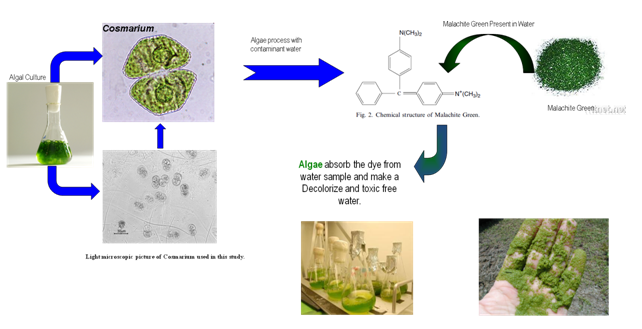 About Authors:
About Authors:
Vedant Pandya
M.Sc. Biotechnology,
Department Of Biotechnology,
Shree M.N.Virani Science College, Rajkot
vedantpandya007@gmail.com
Abstract :
The potential of Cosmarium species, belonging to green Micro algae, was investigated as a viable biomaterial for biological treatment of triphenylmethane dye, Malachite Green (MG). This can be used for the bioremediation of dye effluents. The results obtained from the batch experiments revealed the ability of algal species in removing dye. The effects of operational parameters (temperature, pH, dye concentration and algal concentration) on decolorization were examined. The stability and efficiency of the algae in long-term repetitive operations were also examined. Michaelis–Menten kinetics was used to describe the apparent correlation between the decolorization rate and the dye concentration.
[adsense:336x280:8701650588]
Reference Id: PHARMATUTOR-ART-1375
Introduction :
ü Out of many contaminants present in wastewater, such as acids, bases, toxic organic and inorganic dissolved solids, and colors, colors are considered the most undesirable and are mainly caused by dyes.
ü Dyes are synthetic aromatic water-soluble dispersible organic colorants, having potential application in various industries. The dyestuff usage has been increased day by day because of tremendous increase of industrialization and man’s urge for color.
* Synthetic dyestuffs are used extensively in textile, paper, printing industries and dyehouses. The effluents of these industries are highly colored and the disposal of these wastes into receiving waters causes damage to the environment. Dyes may significantly affect photosynthetic activity in aquatic life because of reduced light penetration and may also be toxic to some aquatic life due to the presence of aromatics and metals, chlorides, etc. Dyes usually have a synthetic origin and complex aromatic molecular structures which make them more stable and more difficult to biodegrade.
[adsense:468x15:2204050025]
* Malachite green (mg) is a triphenyl methane dye, which is most widely used for coloring purpose, amongst all other dyes of its category. MG has properties that make it difficult to remove from aqueous solutions. If the solution containing MG discharged into receiving streams it will affect the aquatic life and cause detrimental effects in liver, gill, kidney, intestine and gonads. In humans, it may cause irritation to the gastrointestinal tract upon ingestion. Contact of MG with skin causes irritation and redness and pain. Upon contact with eye will lead to permanent injury of human eyes and laboratory animals.
* Algae are photosynthetic organisms, which distributed in nearly all parts of the world and in all kinds of habitats. Alga can degrade number of dyes, postulating that the reduction appears to be related to the molecular structure of dyes and the species of algae used.
* Cosmarium is a single-celled placoderm desmid. The cells are deeply divided in the middle by a short isthmus that contains the nucleus. The two semi cells are rounded in front view and flattened, oval, or elliptic in side view. The older half of the cell wall secretes mucilage, while the younger half is lifted off of the substrate at a slight angle. The mucilage swells as it absorbs water and propels the cell forward. The cell wall may be smooth with pores or ornamented with granules, pits, or warts. The vegetative cells usually do not have spines. Each semi cell has at least one central chloroplast with pyrenoids. Cosmarium sometimes produces thick-walled resting cells. We selected cosmarium sp. Because of its availability in Gujarat and also it could be cultured in growth media easily.
* This study aims to investigate the potential of micro algae cosmarium species for decolorization of solution containing a cationic textile dye, malachite green.
* Correlation of the kinetic properties with dye concentration and other rate-dependent environmental parameters (temperature, ph, dye concentration and algal concentration) was characterized. In addition, the stability and reusability of alga during repetitive decolorization operations were examined.
NOW YOU CAN ALSO PUBLISH YOUR ARTICLE ONLINE.
SUBMIT YOUR ARTICLE/PROJECT AT articles@pharmatutor.org
Subscribe to PharmaTutor Alerts by Email
FIND OUT MORE ARTICLES AT OUR DATABASE
Method :
1. Algal bimass :-
The algal species was acquired from natural lake and used immediately. According to its morphology and microscopic observations, it is identified as Cosmarium species belonging to green algae. Cosmarium is a freshwater member of Chlorophyta, green algae. Cosmarium biomass was measured by counting the number of cells by optical microscopy
2. Growth medium :-
Bold’s basal growth medium used for Cosmarium sp.
3. Dye analysis :-
The triphenylmethane dye used in this study Of Malachite Green, the absorbance was measured with spectrophotometer. Decolorization was determined from absorbance calibration curve of standard solutions. The efficiency of color removal was expressed as the percentage ratio of decolorized dye concentration to that of initial one.
4. Batch decolorization operation :-
the batch decolorization experiments were carried out at different initial dye concentrations (0–15 ppm), algal concentrations,temperatures and pH values . The batch decolorization experiments were performed under a static- incubation condition.
Other application of microalgae :
1. Health supplement :- Micro algae act as alternate protein source and food supplement that positively affect human health.
2. Animal feed meal supplement :- Large number of nutritional and toxicological evaluation conducted in the past demonstrated the suitability of micro algal biomass as a animal feed supplement.
3. Biofual :- Oil producing micro algae grown in non-Arabic land are ideal feedstock for biofuel.
4. Carbon Dioxide fixation :- Micro algae absorb Co2 and produce O2 this lead micro algae to become one of the most promising tool to reduce Co2 emission.
5. Aquaculture Ecology :- Micro algae is able to regulate pond condition and enhance livestock productivity by stabilizing the Marine food chain.
6. Cosmetic and Pharmaceutical product :- Clinical study have shown that extract from micro algae such as astaxanthin and phycocyanin improve immunity and are useful for anti-aging and photo protective treatment.

Conclusion :
The present study revealed the ability of the Cosmarium species to decolorize Malachite Green. the decolorization is dependent on the dye concentration, algal concentration, pH and temperature. The dependence of the specific decolorization rate on dye concentration could be described by Michaelis- Menten model. The decolorization rate increased with the temperature rise.
Refrences:
1. Biological decolorization of dye solution containing Malachite Green by microalgae Cosmarium sp. By-N. Daneshvar a, M. Ayazloo, A.R. Khataee, M. Pourhassan, University of Tabriz, Tabriz, Iran
2. Gupta, V.K., Mittal, A., Gajbe, V., 2005a. Adsorption and desorption studies of a water soluble dye, Quilnoline Yellow, using waste materials. J. Colloid Interf. Sci. 284, 89–98.
3. Pakistan journal of Biological science 11(10): 1310-1316, 2008 a article bye, Hanan Hafez Umer, Tanta University.
4. Land Contamination & Reclamation, 15 (3), 2007 DOI 10.2462/09670513.831, article by, S.M. Imamul Huq, Marzia Binte Abdullah and J.C. Joardar.
5. Algae as a Potential Bioremediation Tool for Atrazine Contamination Written by Kyle Enot and Advised by Tracy Gartner SURE Program Summer 2010
6. Effect of pH on Biosorption of Basic Dye Malachite Green bt Algae Kawin Pansamrit and Suneerat Ruangsomboon,Bangkok
7. An integrated process of textile dye removal using cynobacteria, Vishal Shah, Nikki Garg and Datta madamwar, S.P.University, V.V.Nagar. 388120, Gujarat, India.
NOW YOU CAN ALSO PUBLISH YOUR ARTICLE ONLINE.
SUBMIT YOUR ARTICLE/PROJECT AT articles@pharmatutor.org
Subscribe to PharmaTutor Alerts by Email
FIND OUT MORE ARTICLES AT OUR DATABASE










